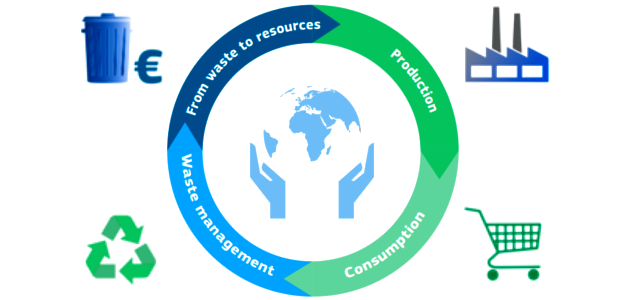What most industries do right now is: Take, Make and Dispose. Extract resources, process them into products, dispose off after use as waste. This is a linear system.
 In a circular economy model, we learn from the Earth’s natural systems. Whatever nature produces, goes back to nature and this cycle indefinitely repeats (a very simple example would be, a plant grows from the soil, lives and uses water/resources, dies and decomposes back into soil providing nutrients for other plants).
In a circular economy model, we learn from the Earth’s natural systems. Whatever nature produces, goes back to nature and this cycle indefinitely repeats (a very simple example would be, a plant grows from the soil, lives and uses water/resources, dies and decomposes back into soil providing nutrients for other plants).
Somebody’s waste is someone else’s food/resource. However-
- You could make a “circular” product – but still not deal with human trafficking and slave labour.
- You could make a “circular” product without necessarily shifting away from using materials that are harmful.
- You could make a “circular” product – but not do a whole lot to regenerate the ecosystem within which it is made or renew the community it is made within.
- You could make a “circular” product – but not put in place the recovery systems and processes to make sure that its circular potential is achieved. Cars that are near 100% recyclable in Europe lose that advantage when they’re shipped to countries without the systems infrastructure for recycling.
That’s why we need a whole-of-systems approach, one with the overall systems goal of regenerating ecosystems and renewing communities.
The major characterization of a circular economy is in the way products and services are planned and designed so waste is minimized and efficiencies are maximized. Recycling is but one component of a circular economy, to capture end-of-life materials and loop them back into the industrial process.
Other components include reuse, repair, re-manufacturing and refurbishing. These are all activities undertaken by companies based on a capitalist system. Many large multinational corporations, such as Philips, Dell, and BMW have started to adapt or expand their business models towards circular economy practices.
The most famous example of a Circular Economy business is Philips Lighting: Sustainable lighting. Another great example is Dell: Design for Environment who are also reprocessing plastic waste from the ocean Also Micheline Tyres: Tyres-as-a-service and you can read a case study conducted by Harvard Business School: Michelin: Tires-as-a-Service.
For smaller companies there is MIWA: WE STOP WASTE BEFORE IT HAPPENS. who designed a product delivery system to reduce waste.
The Circular Economy is, fundamentally, a business lead and driven set of initiatives as businesses are the ones that process natural resources to be sold to consumers. Therefore change starts with them.






